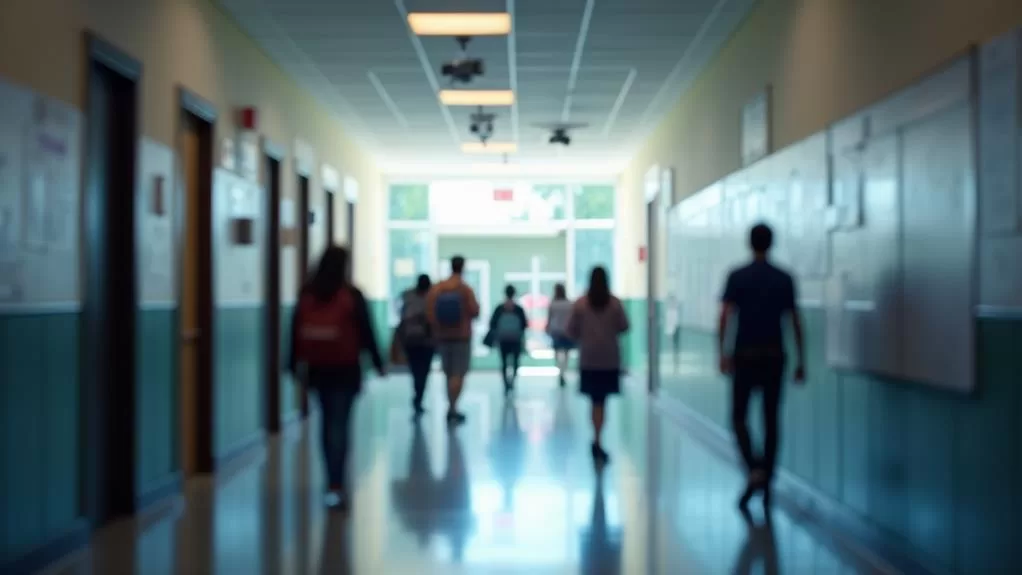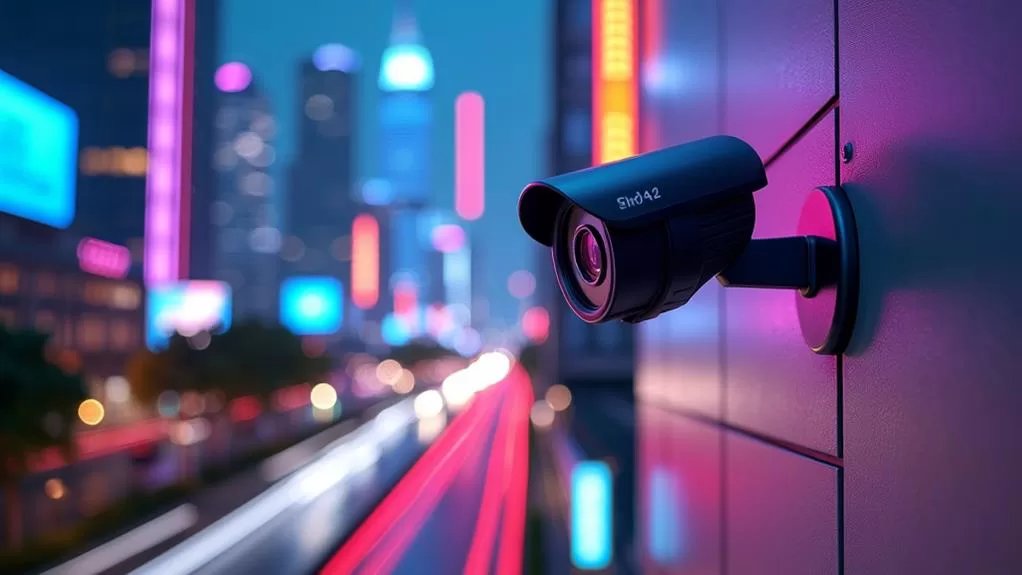AI cameras in schools greatly improve security by allowing real-time threat detection, behavioral analysis, and proactive measures. These cameras utilize AI-based video analytics to distinguish between regular activities and threats, decreasing false alarms and optimizing resource deployment. While enhancing security, it's vital to guarantee privacy protections, such as anonymizing footage, careful use of facial recognition, and compliance with data protection regulations. By integrating these measures, schools can uphold stringent privacy standards while enhancing their security posture. If you're interested in learning more about how these systems operate and their consequences, there's a lot more to explore on this topic.
Key Takeaways
- AI Cameras and Privacy: AI cameras in schools use anonymity in footage to protect identities, ensuring privacy while enhancing security.
- Facial Recognition Balancing: Facial recognition technology is cautiously used to balance privacy and security, alerting personnel to unauthorized access attempts.
- Data Protection Regulations: Schools adhere to strict data protection regulations and conduct privacy impact assessments to safeguard privacy.
- Real-Time Alerts and Anonymity: AI cameras provide real-time threat detection alerts while maintaining anonymity to protect student identities.
- Integrated Access Control: AI cameras integrate with access control systems, enhancing security measures without compromising privacy.
Key Control and Access Management
When it comes to securing the safety and protection of K-12 schools, key control and access management are vital components. Electronic key control is necessary for maintaining a secure environment, as it helps prevent unauthorized access to sensitive areas, a fundamental component of the overall security strategy. Centralized control allows for efficient security management, enabling schools to track who accesses keys, when, and for what purpose. This enhances accountability and guarantees compliance with regulations such as FERPA.
However, the integration of key control with advanced technologies like AI cameras can further improve proactive security measures. While AI cameras contribute to enhanced monitoring and early detection of threats, they must be balanced with considerations for privacy.
Real-time alerts and analytics are essential for effective key control and access management, enabling immediate response to potential security breaches. These systems can alert administrators to unauthorized access attempts and monitor entry points continuously, ensuring a rapid response in emergency situations. By combining robust key control policies with advanced security technologies, schools can create a safer, more secure environment for everyone.
AI-Based Video Analytics
AI-based video analytics in schools enable real-time threat detection by analyzing footage for anomalies such as unauthorized individuals or suspicious objects, providing immediate alerts to on-site security personnel. These systems differentiate between normal activities and potential threats, allowing for proactive security measures and quick intervention in case of emergencies.
By using Smart AI Human Detection, the system can reduce false alarms and focus on genuine threats.
Real-Time Threat Detection
In the midst of evolving security challenges, schools are turning to AI-powered video analytics to strengthen their safety measures. This technology enables real-time threat detection, a critical component in guaranteeing the safety of students and staff.
- Instant Alerts: AI cameras generate immediate alerts for security personnel upon detecting anomalies, guaranteeing swift response to potential threats.
- Behavior Differentiation: These systems differentiate between normal activities and suspicious behavior, reducing false alarms and optimizing resource deployment.
- Proactive Approach: The integration of AI in video surveillance enhances security measures by providing proactive threat detection capabilities, allowing schools to address threats before they escalate.
- Efficient Resource Use: By accurately identifying and alerting security personnel to genuine threats, AI-powered video analytics maximize operational efficiency and enhance security protocols.
These advancements make AI cameras invaluable in schools, as they provide a robust layer of security without compromising privacy protection. By leveraging AI-based video analytics, schools can create a safer environment where students can learn without undue concern for their safety.
This technology not only detects dangerous objects and unauthorized individuals but also guarantees that security personnel can respond swiftly and effectively, making schools safer places for everyone.
Anomaly and Event Alerts
As we focus on the proactive measures provided by AI-powered video analytics, it's clear that real-time anomaly and event alerts are a cornerstone of enhanced school security. AI-based video analytics offer the capacity to detect and alert security personnel to anomalies in real-time, notably improving response time and threat prevention. These alerts are triggered by abnormal activities, unauthorized access attempts, or potential threats, ensuring that security teams can intervene promptly.
The anomaly detection capabilities of these systems differentiate between normal behaviors and anomalies, reducing false alarms and enhancing the efficiency of security measures. By continuously monitoring video feeds, AI algorithms can identify unusual patterns or behaviors that might indicate security breaches or other issues, such as fighting or medical emergencies.
This real-time monitoring and alert system not only enhances security but also maximizes operational efficiency. Security personnel can focus on critical tasks while relying on AI to flag anomalies, ensuring a more proactive and effective approach to school safety.
The integration of AI-based video analytics into existing security systems further strengthens the security posture of schools, providing peace of mind for students, staff, and families.
Privacy Protection Measures
Safeguarding privacy while leveraging AI-based video analytics in schools is a critical concern. As we integrate these advanced security tools into our educational environments, it's vital to balance security needs with the protection of individual privacy rights.
To achieve this balance, several key measures are implemented:
- Anonymity in Footage: AI-based video analytics can anonymize individuals' identities in footage, providing a layer of privacy protection.
- Cautious Use of Facial Recognition: Facial recognition technology is used judiciously to prevent privacy breaches and unauthorized access, given its sensitive nature and potential for misuse.
- Data Protection Regulations: AI cameras adhere to stringent data protection regulations to safeguard students' and staff members' privacy, ensuring that any data collected is handled securely.
- Privacy Impact Assessments: Schools conduct privacy impact assessments to guarantee AI camera systems comply with privacy laws and guidelines, minimizing potential risks.
These measures help maintain trust and ensure that the use of AI-based video analytics aligns with ethical and legal standards for privacy protection. By prioritizing these steps, schools can enhance security while respecting the privacy rights of everyone on campus.
Real-Time Threat Detection

AI cameras in schools facilitate real-time threat detection by analyzing video feeds for unauthorized individuals or dangerous objects, triggering immediate alerts for potential security threats. This allows on-site security personnel to respond rapidly, guaranteeing swift intervention.
Through AI-powered analytics and anomaly detection, these systems differentiate between normal activities and anomalies, reducing false alarms and enhancing resource deployment efficiency. Additionally, these advanced systems can be integrated with secure transactions to guarantee data privacy and protection.
Real-Time Alerts
In the quest to enhance school security, real-time alerts have emerged as an important component of AI-powered video surveillance systems. These alerts play a pivotal role in ensuring immediate responses to potential threats, thereby bolstering the overall security posture of educational institutions.
- Immediate Notification: AI cameras provide real-time alerts for detecting unauthorized individuals or dangerous objects, enabling immediate notification to on-site security personnel for prompt responses.
- Differentiation of Anomalies: AI technology differentiates between normal activities and anomalies to reduce false alarms, ensuring that only genuine threats trigger alerts.
- Efficient Resource Deployment: These alerts trigger efficient resource deployment for enhanced security measures, allowing security personnel to act swiftly and effectively.
- Proactive Security Measures: Real-time threat detection through AI cameras enhances schools' ability to proactively address potential security risks, preventing incidents from escalating.
AI-Powered Analytics
Real-time alerts from AI cameras are just the beginning of a robust school security strategy. AI-powered analytics take school security to the next level by enabling real-time threat detection and alerts. These advanced algorithms actively analyze video feeds for potential threats such as unauthorized access or weapons, guaranteeing that security personnel can respond swiftly to prevent incidents from escalating.
Key Benefits of AI-Powered Analytics in School Security
| Feature | Description | Impact |
|---|---|---|
| Real-Time Threat Detection | AI algorithms analyze video feeds for potential threats like unauthorized access or weapons. | Rapid responses to prevent incidents. |
| Immediate Alerts | Alerts are generated immediately to notify security personnel of detected threats. | Ensures prompt action to avert danger. |
| Integration with Access Control | Automatic lockdown procedures can be initiated through integration with access control systems. | Enhanced security responses. |
| Automation of Security Responses | AI-powered analytics automate responses, reducing reliance on manual monitoring. | Enhances overall safety measures in schools. |
Anomaly Detection
As schools work on creating a safer environment, the ability to detect anomalies in real-time has become a vital component of their security strategy. AI-powered cameras are at the forefront of this effort, offering advanced anomaly detection capabilities that greatly enhance security measures.
Here are some key ways AI-powered cameras contribute to real-time threat detection:
- Immediate Alerts: AI cameras generate instant alerts for potential threats, enhancing on-site security response capabilities and ensuring prompt intervention.
- Differentiation from Normal Activities: These cameras distinguish between normal activities and anomalies, reducing false alarms and enabling efficient resource deployment.
- Proactive Approach: Anomaly detection through AI cameras ensures a proactive stance on security, allowing for swift intervention to prevent security breaches.
- Enhanced Security Measures: AI technology plays an essential role in enhancing security measures by actively monitoring and detecting potential threats in real-time.
Balancing Security and Privacy
Balancing security and privacy in schools is a delicate task, especially when incorporating AI cameras for threat detection. As schools aim to enhance security, they must guarantee that AI cameras focus on security objectives without infringing on personal privacy. This involves addressing significant privacy concerns associated with these advanced surveillance tools.
Implementing AI cameras in schools requires a careful approach to respect student and staff privacy rights. Schools must adhere to strict privacy regulations and guidelines when deploying these systems, ensuring that data collection is limited to essential security functions. Properly configuring AI cameras helps schools prioritize security measures while safeguarding individuals' privacy. Effective policies and protocols are essential for navigating the delicate balance between security needs and privacy concerns.
To achieve this balance, schools should consider features like automatic privacy protection built into the cameras, such as masking faces or generating redacted streams. This approach maintains visibility for security purposes while reassuring students and staff that their privacy is respected. By integrating these measures, schools can guarantee that AI cameras enhance security without compromising personal freedom.
Facial Recognition and Access Control

Facial recognition technology has become a pivotal element in enhancing school security, particularly when integrated with access control systems. This advanced technology actively identifies unauthorized individuals, preventing potential security threats in real-time.
- Enhanced Security: Facial recognition technology identifies and verifies individuals based on their unique facial characteristics, making it highly secure and challenging to bypass.
- Seamless Access: Authorized personnel can enroll in the system, allowing them to enter restricted areas quickly and conveniently without the need for physical keys or passwords.
- Real-Time Identification: The technology provides real-time monitoring capabilities, alerting security personnel instantly if an unauthorized individual attempts to enter a restricted area.
- Balancing Privacy and Security: While implementing facial recognition for access control in schools, it's crucial to maintain a balance between security measures and privacy concerns to guarantee a secure school environment.
Behavioral Analysis for Early Intervention
Behavioral analysis via AI cameras represents a significant advancement in school security, enabling institutions to proactively identify and address potentially concerning behaviors among students and staff. By monitoring behavioral patterns, AI cameras can detect signs of distress, bullying, or other concerning activities in real-time. This early intervention allows schools to provide prompt support to students in need, fostering a safer and more inclusive learning environment.
AI technology empowers schools to address behavioral issues proactively by detecting anomalies in student behavior. For instance, AI cameras can recognize patterns of behavior and differentiate between normal activities and suspicious irregularities. This enables schools to intervene promptly, potentially defusing situations before they escalate into more serious incidents.
The goal of behavioral analysis with AI cameras is to create a safer and more supportive environment. By identifying potential threats and behavioral issues early, schools can promote a positive school culture. This approach not only enhances school safety but also guarantees that students feel safer and more supported, which is essential for their well-being and academic success.
Weapon Detection and Prevention

As we focus on creating a safer learning environment, AI-powered cameras in schools are now equipped with advanced weapon detection capabilities. These cameras play a pivotal role in identifying and preventing violent incidents on school premises.
- Real-time Identification: AI-powered cameras use sophisticated detection algorithms to spot firearms and other weapons in real-time, enabling swift action to be taken.
- Immediate Alerts: Upon detecting a weapon, these cameras trigger prompt alerts to security personnel and law enforcement, ensuring a rapid police response to potential threats.
- Enhanced Efficiency: By automating the detection process, AI-powered video surveillance maximizes operational efficiency in boosting school security against weapon threats.
- Prevention of Violent Incidents: This technology is a game-changer in thwarting violent incidents, as it allows for proactive measures to be taken before a situation escalates.
These advancements in AI-powered cameras have notably improved the ability to detect and respond to threats, making schools safer for everyone. By integrating these systems into existing security protocols, schools can enhance their overall security posture and provide a safer environment for students and staff.
Enhancing Emergency Response
In the critical minutes following a potential threat, every second counts in school security. This is where AI-powered cameras truly shine, enhancing emergency response protocols to guarantee the safest possible environment for students and staff. When a real-time threat is detected, these cameras trigger immediate alerts to on-site security personnel, enabling a swift and effective response. This proactive measure leverages artificial intelligence to analyze surveillance footage, distinguishing between normal activities and anomalies, reducing false alarms and optimizing resource deployment.
The integration of AI technology into school safety systems elevates emergency response capabilities. By providing real-time alerts and predictive analytics, AI cameras facilitate quicker response times and more accurate threat verification. These advanced security solutions empower schools to be proactive rather than reactive, addressing potential threats before they escalate into more serious incidents.
Integrated security systems, enhanced by AI, turn traditional surveillance into a dynamic tool for detecting and responding to emergencies, thereby lowering the risk and optimizing resource deployment. With AI-driven security technology, schools can implement robust and efficient emergency response protocols, safeguarding their communities through advanced predictive analytics and real-time threat detection.
Frequently Asked Questions
Do Security Cameras Make Schools Safer?
Security cameras enhance student safety by boosting surveillance effectiveness, preventing crimes, and monitoring behavior, but they also raise privacy concerns, requiring parental consent, data protection, and careful consideration of legal and ethical implications.
What Is the AI Security Camera for Schools?
An AI security camera for schools uses facial recognition, behavior analysis, and real-time monitoring to detect threats, ensuring student safety while addressing privacy concerns and data protection through advanced intrusion detection and efficient surveillance footage management.
How Does AI Help in Terms of Security and Surveillance?
AI helps me enhance school security through facial recognition, behavior analysis, and real-time alerts for threat detection. It integrates with access control, enables remote monitoring, and streamlines incident response while ensuring privacy protection and efficient data storage.
Are Cameras in Classrooms an Invasion of Privacy?
Installing cameras in classrooms can be seen as an invasion of privacy, but transparency, parental permission, and student consent can mitigate concerns. Legal and ethical considerations, data protection, and clear limits on surveillance are essential to respect privacy rights.
Final Thoughts
To sum up, AI cameras in schools are a double-edged sword, providing advanced security through real-time threat detection and behavioral analysis, but also raising significant privacy concerns. To strike a balance, schools must integrate AI-based video analytics with automatic privacy protection, like face masking, and maintain strict control over access and data management. By taking these steps, schools can establish a safer environment while honoring the privacy rights of students and staff.









